Assessment of Habitat Risks Caused by Human Activities and Integrated Approach to Marine Spatial Planning: The Case of Sriracha District—Sichang Island
Abstract
:1. Introduction
1.1. Marine and Coastal Resources
1.2. Marine and Coastal Resources
1.3. Ecosystem Services in the Demonstration Areas
1.4. Influence of Environmental Factors on Marine and Coastal Resources
1.5. Integrated Coastal Management (ICM)
2. Materials and Methods
2.1. Study Area
2.2. Data Collections and Data Analysis
2.3. InVEST Model
2.4. Correlation Analysis
3. Results
3.1. Habitat Quality
3.2. Habitat Risk Assessment
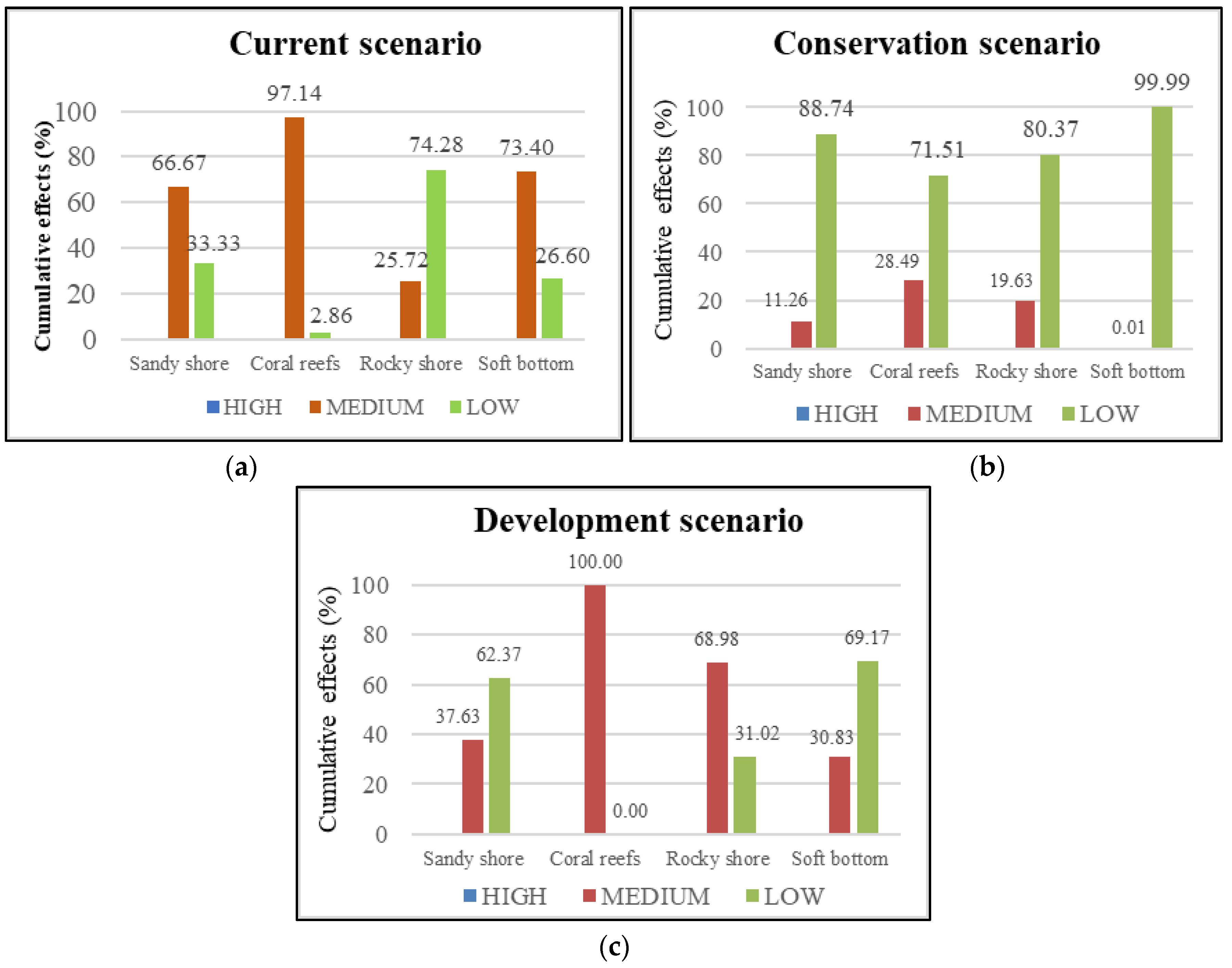
4. Discussion
5. Conclusions
Author Contributions
Funding
Institutional Review Board Statement
Informed Consent Statement
Data Availability Statement
Acknowledgments
Conflicts of Interest
References
- Duarte, G.T.; Ribeiro, M.C.; Paglia, A.P. Ecosystem Services Modeling as a Tool for Defining Priority Areas for Conservation. PLoS ONE 2016, 11, e0154573. [Google Scholar] [CrossRef] [PubMed] [Green Version]
- Zhai, T.; Wang, J.; Fang, Y.; Qin, Y.; Huang, L.; Chen, Y. Assessing ecological risks caused by human activities in rapid urbanization coastal areas: Towards an integrated approach to determining key areas of terrestrial-oceanic ecosystems preservation and restoration. Sci. Total. Environ. 2020, 708, 135153. [Google Scholar] [CrossRef] [PubMed]
- World Bank Thai Flood 2011: Rapid Assessment for Resilient Recovery and Reconstruction Planning; World Bank: Washington, DC, USA, 2012.
- Tangvitoontham, N.; Chaiwat, P. Economic Feasibility Evaluation of Government Investment Project by Using Cost Benefit Analysis: A Case Study of Domestic PortPort A), Laem-Chabang Port, Chonburi Province. Procedia Econ. Finance 2012, 2, 307–314. [Google Scholar] [CrossRef] [Green Version]
- Frederick Grassle, J. Marine Ecosystems. In Encyclopedia of Biodiversity; Elsevier: Amsterdam, The Netherlands, 2013; pp. 45–55. ISBN 9780123847201. [Google Scholar]
- Gu, J.-D.; Wang, Y.-S. Marine coastal ecosystem and ecotoxicology. Ecotoxicology 2020, 29, 639–640. [Google Scholar] [CrossRef]
- OSPAR Commission. Trend Analysis of Maritime Human Activities and Their Collective Impact on the OSPAR Maritime Area. Available online: https://www.ospar.org/about/publications/page25 (accessed on 20 June 2020).
- Turok, I.; McGranahan, G. Urbanization and economic growth: The arguments and evidence for Africa and Asia. Environ. Urban. 2013, 25, 465–482. [Google Scholar] [CrossRef]
- Gomes, E.; Banos, A.; Abrantes, P.; Rocha, J.; Schläpfer, M. Future land use changes in a peri-urban context: Local stakeholder views. Sci. Total Environ. 2020, 718, 137381. [Google Scholar] [CrossRef]
- Buhl-Mortensen, L.; Galparsoro, I.; Fernández, T.V.; Johnson, K.; D’Anna, G.; Badalamenti, F.; Garofalo, G.; Carlström, J.; Piwowarczyk, J.; Rabaut, M.; et al. Maritime ecosystem-based management in practice: Lessons learned from the application of a generic spatial planning framework in Europe. Mar. Policy 2017, 75, 174–186. [Google Scholar] [CrossRef]
- Cantin, M.; Bédard, J.; Milne, H. The food and feeding of common eiders in the St. Lawrence estuary in summer. Can. J. Zool. 1974, 52, 319–334. [Google Scholar] [CrossRef]
- Defeo, O.; McLachlan, A.; Schoeman, D.S.; Schlacher, T.A.; Dugan, J.; Jones, A.; Lastra, M.; Scapini, F. Threats to sandy beach ecosystems: A review. Estuar. Coast. Shelf Sci. 2009, 81, 1–12. [Google Scholar] [CrossRef]
- Eddy, T.D.; Lam, V.W.Y.; Reygondeau, G.; Cisneros-Montemayor, A.M.; Greer, K.; Palomares, M.L.D.; Bruno, J.F.; Ota, Y.; Cheung, W.W. Global decline in capacity of coral reefs to provide ecosystem services. One Earth 2021, 4, 1278–1285. [Google Scholar] [CrossRef]
- OECD Responding to Rising Seas: OECD Country Approaches to Tackling Coastal Risks; OECD: Paris, France, 2019; ISBN 9789264312470.
- Spalding, M.D.; Ruffo, S.; Lacambra, C.; Meliane, I.; Hale, L.Z.; Shepard, C.C.; Beck, M.W. The role of ecosystems in coastal protection: Adapting to climate change and coastal hazards. Ocean Coast. Manag. 2014, 90, 50–57. [Google Scholar] [CrossRef]
- Thompson, R.C.; Crowe, T.P.; Hawkins, S.J. Rocky intertidal communities: Past environmental changes, present status and predictions for the next 25 years. Environ. Conserv. 2002, 29, 168–191. [Google Scholar] [CrossRef]
- Schaefer, N.; Mayer-Pinto, M.; Griffin, K.J.; Johnston, E.L.; Glamore, W.; Dafforn, K.A. Predicting the impact of sea-level rise on intertidal rocky shores with remote sensing. J. Environ. Manag. 2020, 261, 110203. [Google Scholar] [CrossRef] [PubMed]
- Nguyen, P.N.; Woo, S.-H.; Beresford, A.; Pettit, S. Competition, market concentration, and relative efficiency of major container ports in Southeast Asia. J. Transp. Geogr. 2020, 83, 102653. [Google Scholar] [CrossRef]
- EECO. Overall Land Use Plan. Eastern Economic Corridor Office of Thailand. Available online: https://eeco.or.th/th/overall-land-use-plan (accessed on 14 March 2020).
- Vichkovitten, T.; Intarachart, A.; Khaodon, K. Impact of green mussel (Perna viridis) raft-culture on benthic environment in Sriracha coastal water, Thailand. GMSARN Int. J. 2017, 11, 116–122. [Google Scholar]
- Kennedy, A.D.; Jacoby, C. Biological Indicators of Marine Environmental Health: Meiofauna—A Neglected Benthic Component? Environ. Monit. Assess. 1999, 54, 47–68. [Google Scholar] [CrossRef]
- Kumgumpol, H.; Liu, Y.; Pokavanich, T.; Alabia, I.D.; Yin, Z.; Saitoh, S.-I.; Tian, Y. Environmental Habitat Mapping of Green Mussel: A GIS-Based Approach for Sustainable Aquaculture in the Inner Gulf of Thailand. Sustainability 2020, 12, 10643. [Google Scholar] [CrossRef]
- McDowall, S.; Wang, Y. An Analysis of International Tourism Development in Thailand: 1994–2007. Asia Pac. J. Tour. Res. 2009, 14, 351–370. [Google Scholar] [CrossRef]
- Hayes, E.H.; Landis, W.G. Regional Ecological Risk Assessment of a Near Shore Marine Environment: Cherry Point, WA. Hum. Ecol. Risk Assess. Int. J. 2004, 10, 299–325. [Google Scholar] [CrossRef]
- Zohary, T.; Gasith, A. The Littoral Zone. In Lake Kinneret: Ecology and Management; Zohary, T., Sukenik, A., Berman, T., Nishri, A., Eds.; Springer: Dordrecht, The Netherlands, 2014; pp. 517–532. [Google Scholar]
- Gasith, A.; Gafny, S. Effects of Water Level Fluctuation on the Structure and Function of the Littoral Zone. In Large Lakes; Springer: Berlin/Heidelberg, Germany, 1990. [Google Scholar] [CrossRef]
- Department of Marine and Coastal Resources. Coastal Geomorphology. Available online: https://km.dmcr.go.th/c_56/s_77/d_2766 (accessed on 7 March 2022). (In Thai)
- Moberg, F.; Folke, C. Ecological goods and services of coral reef ecosystems. Ecol. Econ. 1999, 29, 215–233. [Google Scholar] [CrossRef]
- Ferrier-Pagès, C.; Leal, M.C.; Calado, R.; Schmid, D.W.; Bertucci, F.; Lecchini, D.; Allemand, D. Noise pollution on coral reefs?—A yet underestimated threat to coral reef communities. Mar. Pollut. Bull. 2021, 165, 112129. [Google Scholar] [CrossRef] [PubMed]
- Granek, E.F.; Polasky, S.; Kappel, C.V.; Reed, D.J.; Stoms, D.M.; Koch, E.W.; Kennedy, C.J.; Cramer, L.A.; Hacker, S.D.; Barbier, E.B.; et al. Ecosystem Services as a Common Language for Coastal Ecosystem-Based Management. Conserv. Biol. 2010, 24, 207–216. [Google Scholar] [CrossRef] [PubMed]
- Daily, G. (Ed.) Nature’s Services: Societal Dependence on Natural Ecosystems; Island Press: Washington, DC, USA, 1997; ISBN 9781559634762. [Google Scholar]
- Chakraborty, S.; Gasparatos, A.; Blasiak, R. Multiple values for the management and sustainable use of coastal and marine ecosystem services. Ecosyst. Serv. 2019, 41, 101047. [Google Scholar] [CrossRef]
- Costanza, R.; d’Arge, R.; de Groot, R.; Farber, S.; Grasso, M.; Hannon, B.; Limburg, K.; Naeem, S.; O’Neill, R.V.; Paruelo, J.; et al. The value of the world’s ecosystem services and natural capital. Nature 1997, 387, 253–260. [Google Scholar] [CrossRef]
- Hutchison, L.; Montagna, P.; Yoskowitz, D.; Scholz, D.; Tunnell, J. Stakeholder Perceptions of Coastal Habitat Ecosystem Services. Estuaries Coasts 2013, 38, 67–80. [Google Scholar] [CrossRef]
- Costanza, R.; De Groot, R.; Braat, L.; Kubiszewski, I.; Fioramonti, L.; Sutton, P.; Farber, S.; Grasso, M. Twenty years of ecosystem services: How far have we come and how far do we still need to go? Ecosyst. Serv. 2017, 28, 1–16. [Google Scholar] [CrossRef]
- Qi, Y.; Lian, X.; Wang, H.; Zhang, J.; Yang, R. Dynamic mechanism between human activities and ecosystem services: A case study of Qinghai lake watershed, China. Ecol. Indic. 2020, 117, 106528. [Google Scholar] [CrossRef]
- Department of Fisheries (DoF). The Master Plan on Thailand’s Aquaculture Development (2017–2021); Ministry of Agriculture and Cooperatives: Bangkok, Thailand, 2019.
- Tiprak, W. An Application of Cultural Resource to Develop Community Based Tourism in Bangphra Seaside, Sriracha District Chonburi Province. Inst. Cult. Arts J. 2017, 19, 136–143. [Google Scholar]
- Wang, Y.; Sun, C.; Zou, W. Study on the Interactive Relationship Between Marine Economic Growth and Marine Environmental Pressure in China. Environ. Resour. Econ. 2021, 79, 117–133. [Google Scholar] [CrossRef]
- Department of Marine and Coastal Resources (DMCR). The 2018 Marine and Coastal Resources and Coastal Erosion Situations of Thailand. Available online: https://www.dmcr.go.th/detailLib/4933 (accessed on 10 March 2020).
- Temple, A.J.; Skerritt, D.J.; Howarth, P.E.; Pearce, J.; Mangi, S.C. Illegal, unregulated and unreported fishing impacts: A systematic review of evidence and proposed future agenda. Mar. Policy 2022, 139, 105033. [Google Scholar] [CrossRef]
- Nasuchon, N.; Charles, A. Community involvement in fisheries management: Experiences in the Gulf of Thailand countries. Mar. Policy 2009, 34, 163–169. [Google Scholar] [CrossRef]
- Sander, K.; Lee, J.; Hickey, V.; Mosoti, V.B.; Virdin, J.; Magrath, W.B. Conceptualizing maritime environmental and natural resources law enforcement–The case of illegal fishing. Environ. Dev. 2014, 11, 112–122. [Google Scholar] [CrossRef]
- Viana, M.; Hammingh, P.; Colette, A.; Querol, X.; Degraeuwe, B.; de Vlieger, I.; van Aardenne, J. Impact of maritime transport emissions on coastal air quality in Europe. Atmos. Environ. 2014, 90, 96–105. [Google Scholar] [CrossRef]
- Christiansen, M.; Fagerholt, K.; Nygreen, B.; Ronen, D. Chapter 4 Maritime Transportation. In Transportation; Elsevier: Amsterdam, The Netherlands, 2007; pp. 189–284. ISBN 9780444513465. [Google Scholar]
- Wang, C.; Corbett, J.; Firestone, J. Improving Spatial Representation of Global Ship Emissions Inventories. Environ. Sci. Technol. 2007, 42, 193–199. [Google Scholar] [CrossRef]
- Gollasch, S.; Minchin, D.; David, M. The Transfer of Harmful Aquatic Organisms and Pathogens with Ballast Water and Their Impacts. In Global Maritime Transport and Ballast Water Management; Springer: Dordrecht, The Netherlands, 2015; pp. 35–58. [Google Scholar] [CrossRef]
- Purba, N.P.; Handyman, D.I.; Pribadi, T.D.; Syakti, A.D.; Pranowo, W.S.; Harvey, A.; Ihsan, Y.N. Marine debris in Indonesia: A review of research and status. Mar. Pollut. Bull. 2019, 146, 134–144. [Google Scholar] [CrossRef]
- Wiegers, J.K.; Feder, H.M.; Mortensen, L.S.; Shaw, D.G.; Wilson, V.J.; Landis, W.G. A Regional Multiple-Stressor Rank-Based Ecological Risk Assessment for the Fjord of Port Valdez, Alaska. Hum. Ecol. Risk Assess. Int. J. 1998, 4, 1125–1173. [Google Scholar] [CrossRef]
- Sundblad, G.; Bergström, U. Shoreline development and degradation of coastal fish reproduction habitats. AMBIO 2014, 43, 1020–1028. [Google Scholar] [CrossRef] [Green Version]
- VanWormer, E.; Carpenter, T.E.; Singh, P.; Shapiro, K.; Wallender, W.W.; Conrad, P.A.; Largier, J.L.; Maneta, M.P.; Mazet, J.A.K. Coastal development and precipitation drive pathogen flow from land to sea: Evidence from a Toxoplasma gondii and felid host system. Sci. Rep. 2016, 6, 29252. [Google Scholar] [CrossRef]
- Burt, J.A.; Bartholomew, A. Towards more sustainable coastal development in the Arabian Gulf: Opportunities for ecological engineering in an urbanized seascape. Mar. Pollut. Bull. 2019, 142, 93–102. [Google Scholar] [CrossRef]
- Wong, P. Coastal tourism development in Southeast Asia: Relevance and lessons for coastal zone management. Ocean Coast. Manag. 1998, 38, 89–109. [Google Scholar] [CrossRef]
- Papageorgiou, M. Coastal and marine tourism: A challenging factor in Marine Spatial Planning. Ocean Coast. Manag. 2016, 129, 44–48. [Google Scholar] [CrossRef]
- Leposa, N. Problematic blue growth: A thematic synthesis of social sustainability problems related to growth in the marine and coastal tourism. Sustain. Sci. 2020, 15, 1233–1244. [Google Scholar] [CrossRef] [Green Version]
- Poltanee, I.; Boonphetkaew, U.; Chomali, T.; Moonlakorn, N.; Kanitittiwat, S.; Klanbut, S.; Prasertnok, A. A Study of Im-pacts of Marine Tourism According to the Components of Sustainable Tourism in Koh Larn Area, Bang Lamung District, Chonburi Province. Bang Lamung Dist. 2021, 16, 98–110. [Google Scholar]
- Eng, C.T.; Paw, J.N.; Guarin, F.Y. The environmental impact of aquaculture and the effects of pollution on coastal aquaculture development in Southeast Asia. Mar. Pollut. Bull. 1989, 20, 335–343. [Google Scholar] [CrossRef]
- Chua, T.-E. Coastal aquaculture development and the environment: The role of coastal area management. Mar. Pollut. Bull. 1992, 25, 98–103. [Google Scholar] [CrossRef]
- Landesman, L.J. Negative Impacts of Coastal Tropical Aquaculture Developments. World Aquac. 1994, 25, 12–17. [Google Scholar]
- Godschalk, D.R. Coastal Zone Management. In Encyclopedia of Ocean Sciences, 2nd ed.; Steele, J.H., Ed.; Academic Press: Oxford, UK, 2009; pp. 599–605. [Google Scholar]
- Cho, L. Marine protected areas: A tool for integrated coastal management in Belize. Ocean Coast. Manag. 2005, 48, 932–947. [Google Scholar] [CrossRef]
- Le Tissier, M. Unravelling the Relationship between Ecosystem-Based Management, Integrated Coastal Zone Manage-ment and Marine Spatial Planning. In Ecosystem-Based Management, Ecosystem Services and Aquatic Biodiversity: Theory, Tools and Applications; O’Higgins, T.G., Lago, M., DeWitt, T.H., Eds.; Springer International Publishing: Cham, Switzerland, 2020; pp. 403–413. [Google Scholar]
- Cicin-Sain, B.; Belfiore, S. Linking marine protected areas to integrated coastal and ocean management: A review of theory and practice. Ocean Coast. Manag. 2005, 48, 847–868. [Google Scholar] [CrossRef]
- Ehler, C.N. Indicators to measure governance performance in integrated coastal management. Ocean Coast. Manag. 2003, 46, 335–345. [Google Scholar] [CrossRef]
- Eger, S.; de Loë, R.; Pittman, J.; Epstein, G.; Courtenay, S. A systematic review of integrated coastal and marine management progress reveals core governance characteristics for successful implementation. Mar. Policy 2021, 132, 104688. [Google Scholar] [CrossRef]
- Douvere, F.; Ehler, C.N. New perspectives on sea use management: Initial findings from European experience with marine spatial planning. J. Environ. Manag. 2009, 90, 77–88. [Google Scholar] [CrossRef] [PubMed]
- Foley, M.M.; Halpern, B.S.; Micheli, F.; Armsby, M.H.; Caldwell, M.R.; Crain, C.M.; Prahler, E.; Rohr, N.; Sivas, D.; Beck, M.W.; et al. Guiding ecological principles for marine spatial planning. Mar. Policy 2010, 34, 955–966. [Google Scholar] [CrossRef]
- Ehler, C. Conclusions: Benefits, lessons learned, and future challenges of marine spatial planning. Mar. Policy 2008, 32, 840–843. [Google Scholar] [CrossRef]
- Ainscough, J.; de Vries Lentsch, A.; Metzger, M.; Rounsevell, M.; Schröter, M.; Delbaere, B.; de Groot, R.; Staes, J. Navigating pluralism: Understanding perceptions of the ecosystem services concept. Ecosyst. Serv. 2019, 36, 100892. [Google Scholar] [CrossRef] [Green Version]
- Arkema, K.K.; Verutes, G.; Bernhardt, J.R.; Clarke, C.; Rosado, S.; Canto, M.; Wood, S.A.; Ruckelshaus, M.; Rosenthal, A.; McField, M.; et al. Assessing habitat risk from human activities to inform coastal and marine spatial planning: A demonstration in Belize. Environ. Res. Lett. 2014, 9, 114016. [Google Scholar] [CrossRef] [Green Version]
- Baral, H.; Keenan, R.J.; Sharma, S.K.; Stork, N.E.; Kasel, S. Spatial assessment and mapping of biodiversity and conservation priorities in a heavily modified and fragmented production landscape in north-central Victoria, Australia. Ecol. Indic. 2014, 36, 552–562. [Google Scholar] [CrossRef]
- Terrado, M.; Sabater, S.; Chaplin-Kramer, B.; Mandle, L.; Ziv, G.; Acuña, V. Model development for the assessment of terrestrial and aquatic habitat quality in conservation planning. Sci. Total Environ. 2016, 540, 63–70. [Google Scholar] [CrossRef] [Green Version]
- Torn, K.; Herkül, K.; Martin, G.; Oganjan, K. Assessment of quality of three marine benthic habitat types in northern Baltic Sea. Ecol. Indic. 2017, 73, 772–783. [Google Scholar] [CrossRef]
- Caro, C.; Marques, J.C.; Cunha, P.P.; Teixeira, Z. Ecosystem services as a resilience descriptor in habitat risk assessment using the InVEST model. Ecol. Indic. 2020, 115, 106426. [Google Scholar] [CrossRef]
- Gomes, E.; Inácio, M.; Bogdzevič, K.; Kalinauskas, M.; Karnauskaitė, D.; Pereira, P. Future scenarios impact on land use change and habitat quality in Lithuania. Environ. Res. 2021, 197, 111101. [Google Scholar] [CrossRef]
- Tussadiah, A.; Sujiwo, A.S.; Andesta, I.; Daeli, W. Assessment of coastal ecosystem services and its condition for policy management plan in East Nusa Tenggara, Indonesia. Reg. Stud. Mar. Sci. 2021, 47, 101941. [Google Scholar] [CrossRef]
- He, Y.; Kuang, Y.; Zhao, Y.; Ruan, Z. Spatial Correlation between Ecosystem Services and Human Disturbances: A Case Study of the Guangdong–Hong Kong–Macao Greater Bay Area, China. Remote Sens. 2021, 13, 1174. [Google Scholar] [CrossRef]
- Natural Capital Project. InVEST 3.9.1.Post2+ug.Gb8532be User’s Guide. Available online: https://naturalcapitalproject.stanford.edu/software/invest-models/habitat-quality (accessed on 3 August 2021).
- Yang, Y. Evolution of habitat quality and association with land-use changes in mountainous areas: A case study of the Taihang Mountains in Hebei Province, China. Ecol. Indic. 2021, 129, 107967. [Google Scholar] [CrossRef]
- Gong, J.; Xie, Y.; Cao, E.; Huang, Q.; Li, H. Integration of InVEST-habitat quality model with landscape pattern indexes to assess mountain plant biodiversity change: A case study of Bailongjiang watershed in Gansu Province. J. Geogr. Sci. 2019, 29, 1193–1210. [Google Scholar] [CrossRef] [Green Version]
- Moreira, M.; Fonseca, C.; Vergílio, M.; Calado, H.; Gil, A. Spatial assessment of habitat conservation status in a Macaronesian island based on the InVEST model: A case study of Pico Island (Azores, Portugal). Land Use Policy 2018, 78, 637–649. [Google Scholar] [CrossRef]
- Xu, Y.; Xu, X.; Tang, Q. Human activity intensity of land surface: Concept, methods and application in China. J. Geogr. Sci. 2016, 26, 1349–1361. [Google Scholar] [CrossRef]
- Zhang, J.; Kitazawa, D. Assessing the bio-mitigation effect of integrated multi-trophic aquaculture on marine environment by a numerical approach. Mar. Pollut. Bull. 2016, 110, 484–492. [Google Scholar] [CrossRef]
- Zhu, C.; Zhang, X.; Zhou, M.; He, S.; Gan, M.; Yang, L.; Wang, K. Impacts of urbanization and landscape pattern on habitat quality using OLS and GWR models in Hangzhou, China. Ecol. Indic. 2020, 117, 106654. [Google Scholar] [CrossRef]
- Cong, W.; Sun, X.; Guo, H.; Shan, R. Comparison of the SWAT and InVEST models to determine hydrological ecosystem service spatial patterns, priorities and trade-offs in a complex basin. Ecol. Indic. 2020, 112, 106089. [Google Scholar] [CrossRef]
- Chopra, K.; Leemans, R.; Kumar, P.; Simons, H. Ecosystems and Human Well-Being: Policy Responses; Island Press: Washington, DC, USA, 2005. [Google Scholar]
- The Natural Capital Project. In VEST Version 3.2.0 User’s Guide. Available online: https://naturalcapitalproject.stanford.edu/software/invest (accessed on 25 January 2020).
- Wang, R.; Zhao, J.; Chen, G.; Lin, Y.; Yang, A.; Cheng, J. Coupling PLUS–InVEST Model for Ecosystem Service Research in Yunnan Province, China. Sustainability 2022, 15, 271. [Google Scholar] [CrossRef]
- Sharp, R.; Tallis, H.T.; Ricketts, T.; Guerry, A.D.; Wood, S.A.; Chaplin-Kramer, R.; Nelson, E.; Ennaanay, D.; Wolny, S.; Olwero, N.; et al. InVEST—Integrated Valuation of Ecosystem Services and Tradeoffs; Stanford University: Stanford, CA, USA, 2016. [Google Scholar]
- Sieber, I.M.; Hinsch, M.; Vergílio, M.; Gil, A.; Burkhard, B. Assessing the effects of different land-use/land-cover input datasets on modelling and mapping terrestrial ecosystem services-Case study Terceira Island (Azores, Portugal). One Ecosyst. 2021, 6, e69119. [Google Scholar] [CrossRef]
- Sil, Â.; Rodrigues, A.P.; Carvalho-Santos, C.; Nunes, J.P.; Honrado, J.; Alonso, J.; Marta-Pedroso, C.; Azevedo, J.C. Trade-offs and Synergies Between Provisioning and Regulating Ecosystem Services in a Mountain Area in Portugal Affected by Landscape Change. Mt. Res. Dev. 2016, 36, 452–464. [Google Scholar] [CrossRef] [Green Version]
- Shi, M.; Wu, H.; Fan, X.; Jia, H.; Dong, T.; He, P.; Baqa, M.F.; Jiang, P. Trade-Offs and Synergies of Multiple Ecosystem Services for Different Land Use Scenarios in the Yili River Valley, China. Sustainability 2021, 13, 1577. [Google Scholar] [CrossRef]
- Zhang, X.; Song, W.; Lang, Y.; Feng, X.; Yuan, Q.; Wang, J. Land use changes in the coastal zone of China’s Hebei Province and the corresponding impacts on habitat quality. Land Use Policy 2020, 99, 104957. [Google Scholar] [CrossRef]
- Duggan, J.M.; Eichelberger, B.A.; Ma, S.; Lawler, J.J.; Ziv, G. Informing management of rare species with an approach combining scenario modeling and spatially explicit risk assessment. Ecosyst. Health Sustain. 2015, 1, 1–18. [Google Scholar] [CrossRef]
- Department of Marine and Coastal Rsources (DMCR). Act on the Promotion of Marine and Coastal Resources Management, B.E. 2558. 2015. Available online: https://www.dmcr.go.th/detailLib/3051 (accessed on 24 June 2021).
- Song, W.; Deng, X. Land-use/land-cover change and ecosystem service provision in China. Sci. Total Environ. 2017, 576, 705–719. [Google Scholar] [CrossRef] [PubMed]
- Walker, T.R.; Adebambo, O.; Del Aguila Feijoo, M.C.; Elhaimer, E.; Hossain, T.; Edwards, S.J.; Morrison, C.E.; Romo, J.; Sharma, N.; Taylor, S.; et al. Environmental Effects of Marine Transportation. In World Seas: An Environmental Evaluation; Elsevier: Amsterdam, The Netherlands, 2019; pp. 505–530. ISBN 978-0-12-805052-1. [Google Scholar]
- Aneseyee, A.B.; Noszczyk, T.; Soromessa, T.; Elias, E. The InVEST Habitat Quality Model Associated with Land Use/Cover Changes: A Qualitative Case Study of the Winike Watershed in the Omo-Gibe Basin, Southwest Ethiopia. Remote Sens. 2020, 12, 1103. [Google Scholar] [CrossRef] [Green Version]
- He, J.; Huang, J.; Li, C. The evaluation for the impact of land use change on habitat quality: A joint contribution of cellular automata scenario simulation and habitat quality assessment model. Ecol. Model. 2017, 366, 58–67. [Google Scholar] [CrossRef]
- Brown, A.; McLachlan, A. Sandy shore ecosystems and the threats facing them: Some predictions for the year 2025. Environ. Conserv. 2002, 29, 62–77. [Google Scholar] [CrossRef] [Green Version]
- National Statistical Office. Annual Statistical Report: Statistical Data Related to the Transportation of Goods and Passengers by Water; Marine Department: Bangkok, Thailand, 2021.
- Stewart, P.L.; Levy, H.A.; Walker, T.R. Benthic Invertebrate Surveys Conducted between 2009–2011 as Part of the Sydney Tar Ponds Cleanup and Coke Ovens Remediation Project. Version 1.2. Canadian Node of the Ocean Biogeographic Information System (OBIS Canada). 2021. Available online: https://www.gbif.org/dataset/e20d61a9-4ba1-41d6-9256-722e8c57cb34 (accessed on 18 January 2022).
- Nedeau, E.J.; Merritt, R.W.; Kaufman, M.G. The effect of an industrial effluent on an urban stream benthic community: Water quality vs. habitat quality. Environ. Pollut. 2003, 123, 1–13. [Google Scholar] [CrossRef]
- Borja, A.; Elliott, M.; Andersen, J.H.; Berg, T.; Carstensen, J.; Halpern, B.S.; Heiskanen, A.-S.; Korpinen, S.; Lowndes, J.S.S.; Martin, G.; et al. Overview of Integrative Assessment of Marine Systems: The Ecosystem Approach in Practice. Front. Mar. Sci. 2016, 3, 20. [Google Scholar] [CrossRef] [Green Version]
- Edokpayi, J.N.; Odiyo, J.O.; Durowoju, O.S. Impact of Wastewater on Surface Water Quality in Developing Countries: A Case Study of South Africa. In Water Quality; IntechOpen: London, UK, 2017; pp. 401–416. [Google Scholar]
- Guerry, A.D.; Ruckelshaus, M.H.; Arkema, K.K.; Bernhardt, J.R.; Guannel, G.; Kim, C.-K.; Marsik, M.; Papenfus, M.; Toft, J.E.; Verutes, G.; et al. Modeling benefits from nature: Using ecosystem services to inform coastal and marine spatial planning. Int. J. Biodivers. Sci. Ecosyst. Serv. Manag. 2012, 8, 107–121. [Google Scholar] [CrossRef] [Green Version]
- McKenzie, E.; Posner, S.; Tillmann, P.; Bernhardt, J.R.; Howard, K.; Rosenthal, A. Understanding the Use of Ecosystem Service Knowledge in Decision Making: Lessons from International Experiences of Spatial Planning. Environ. Plan. C Gov. Policy 2014, 32, 320–340. [Google Scholar] [CrossRef]
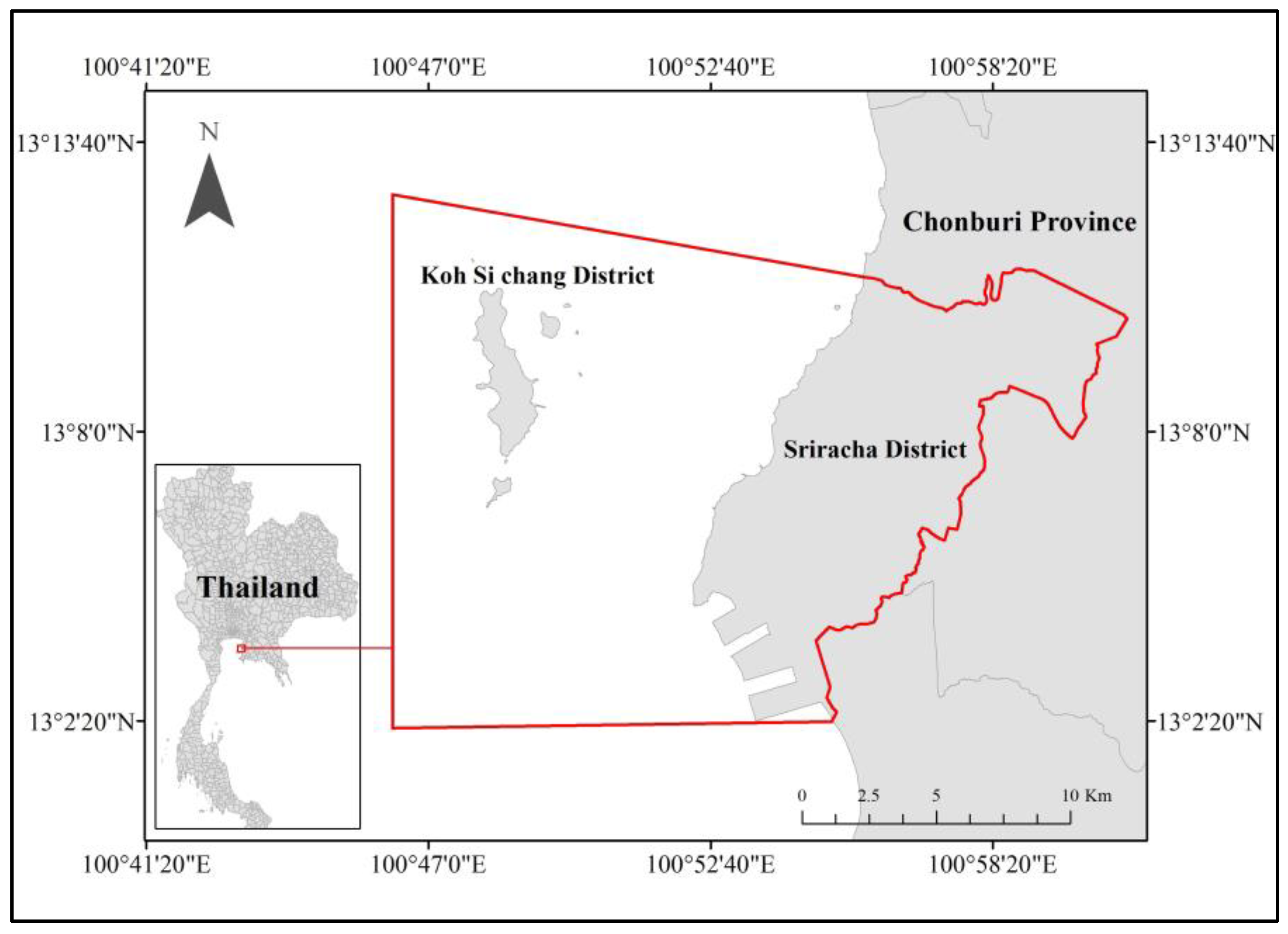
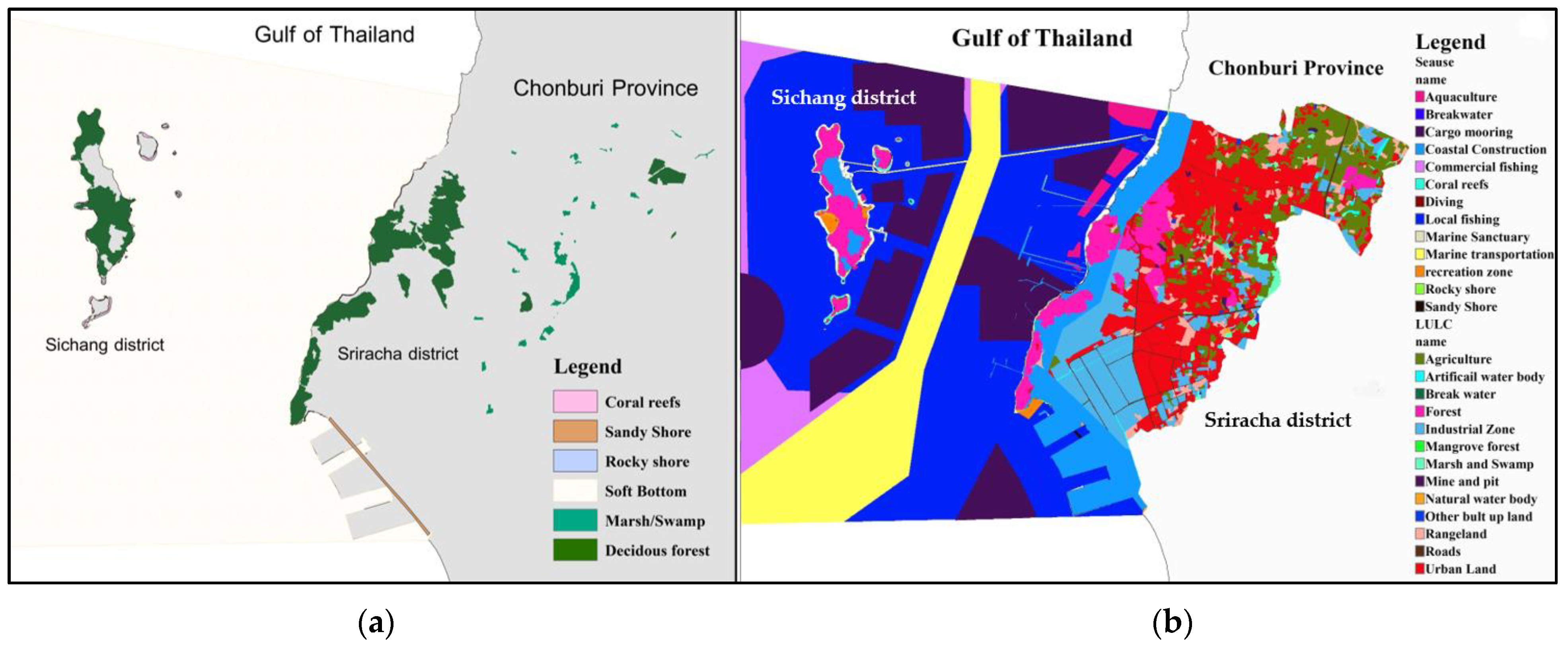
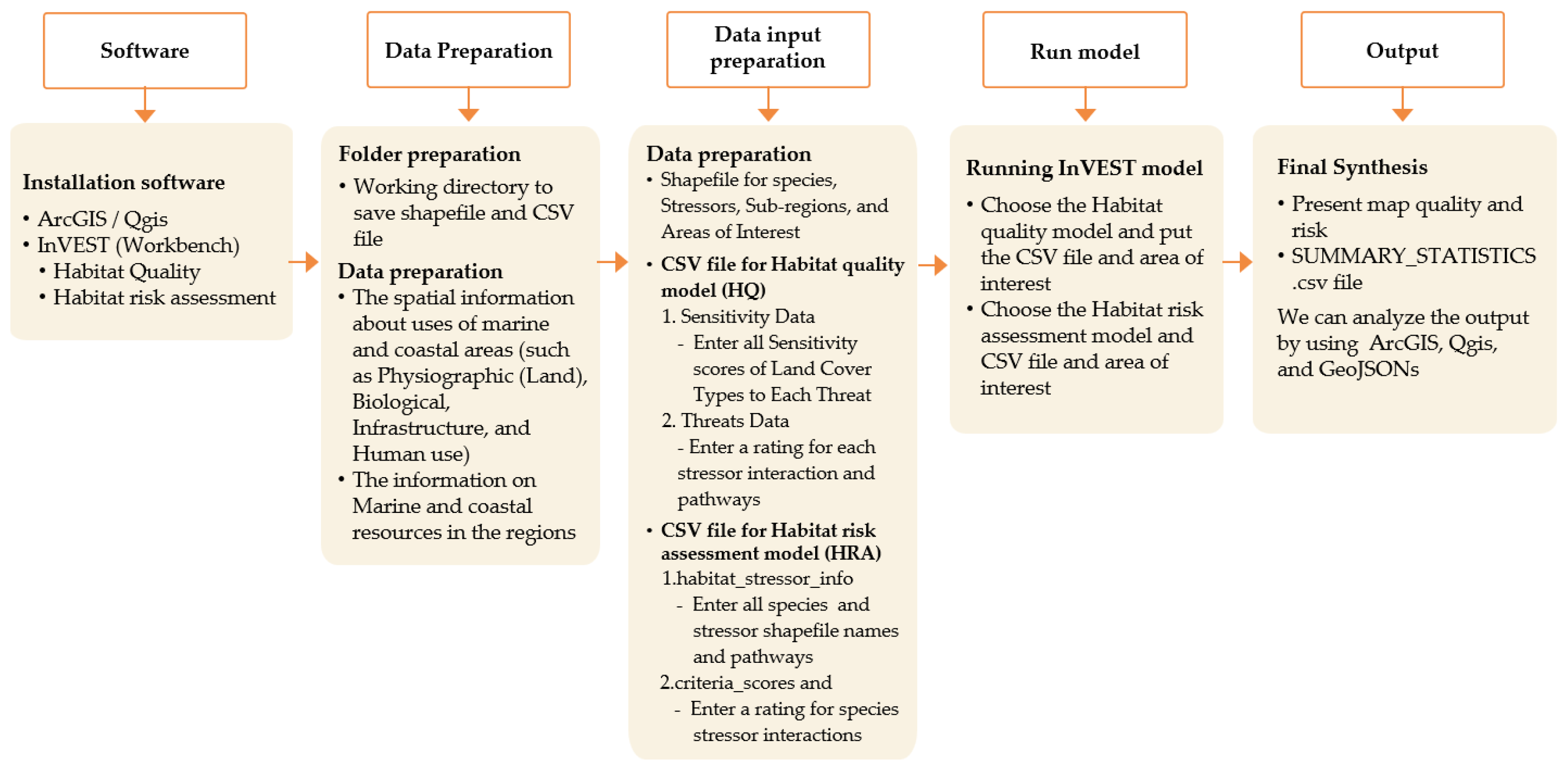
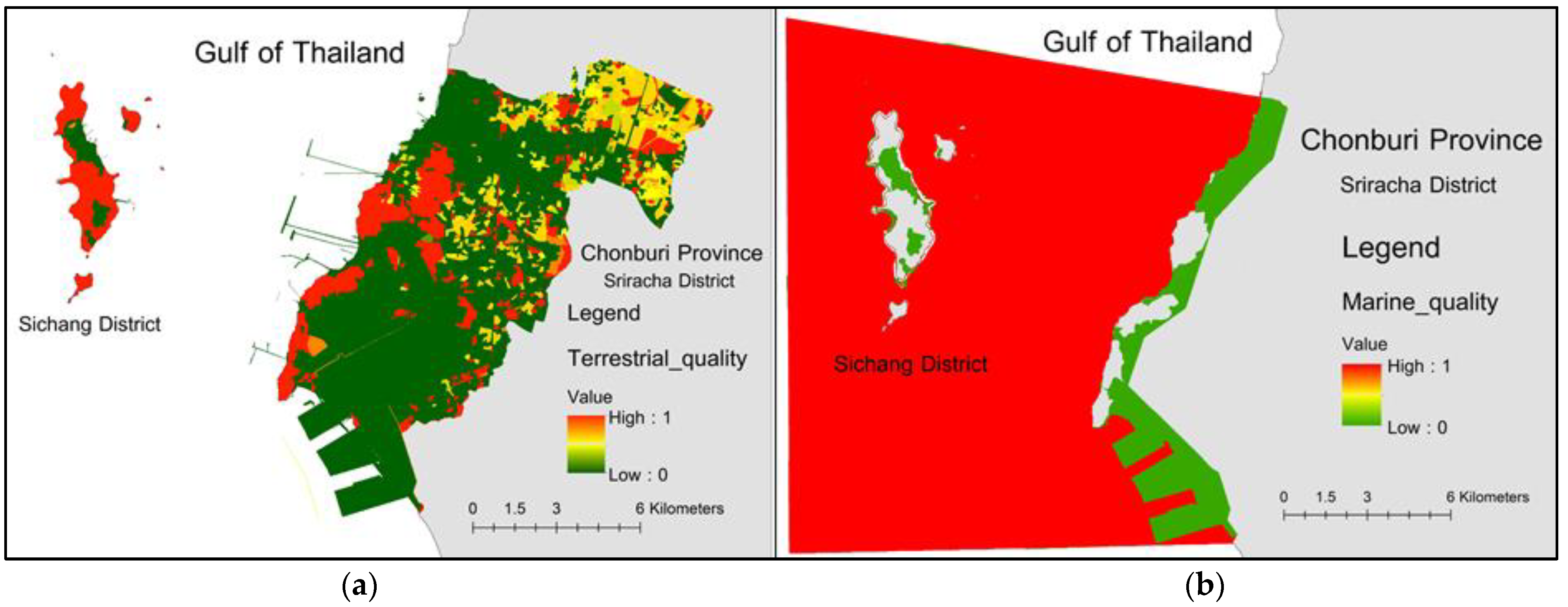

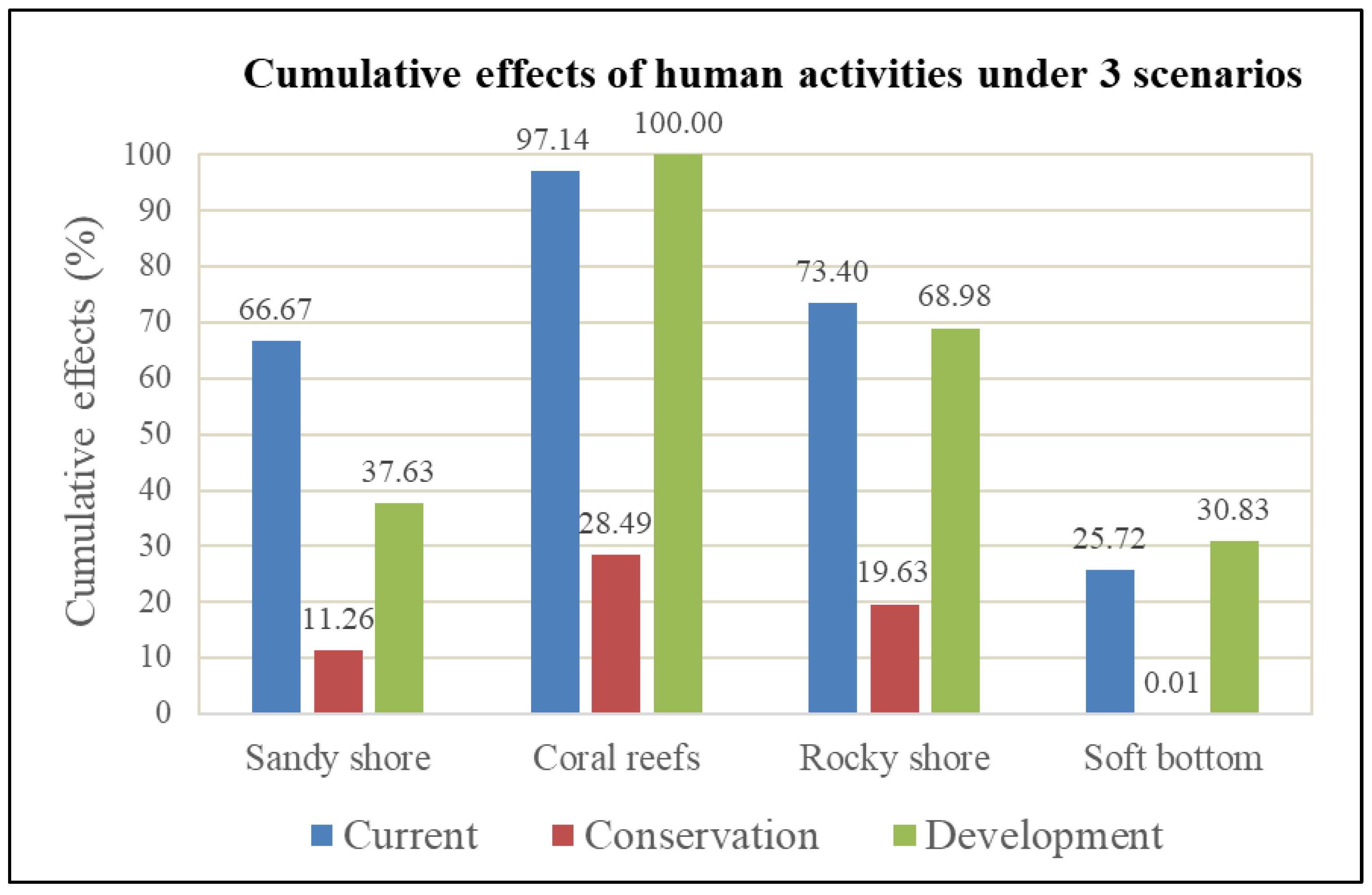
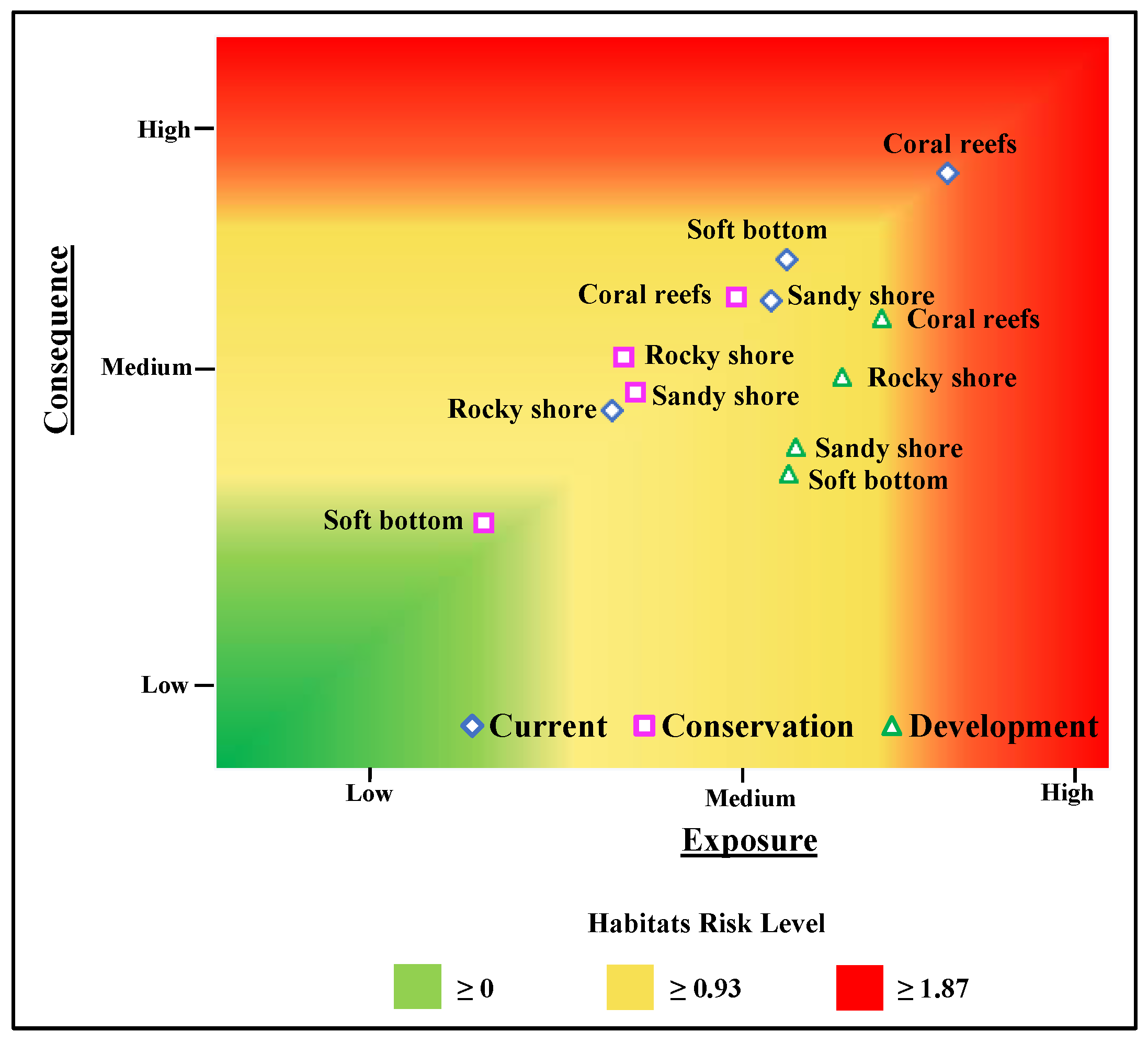
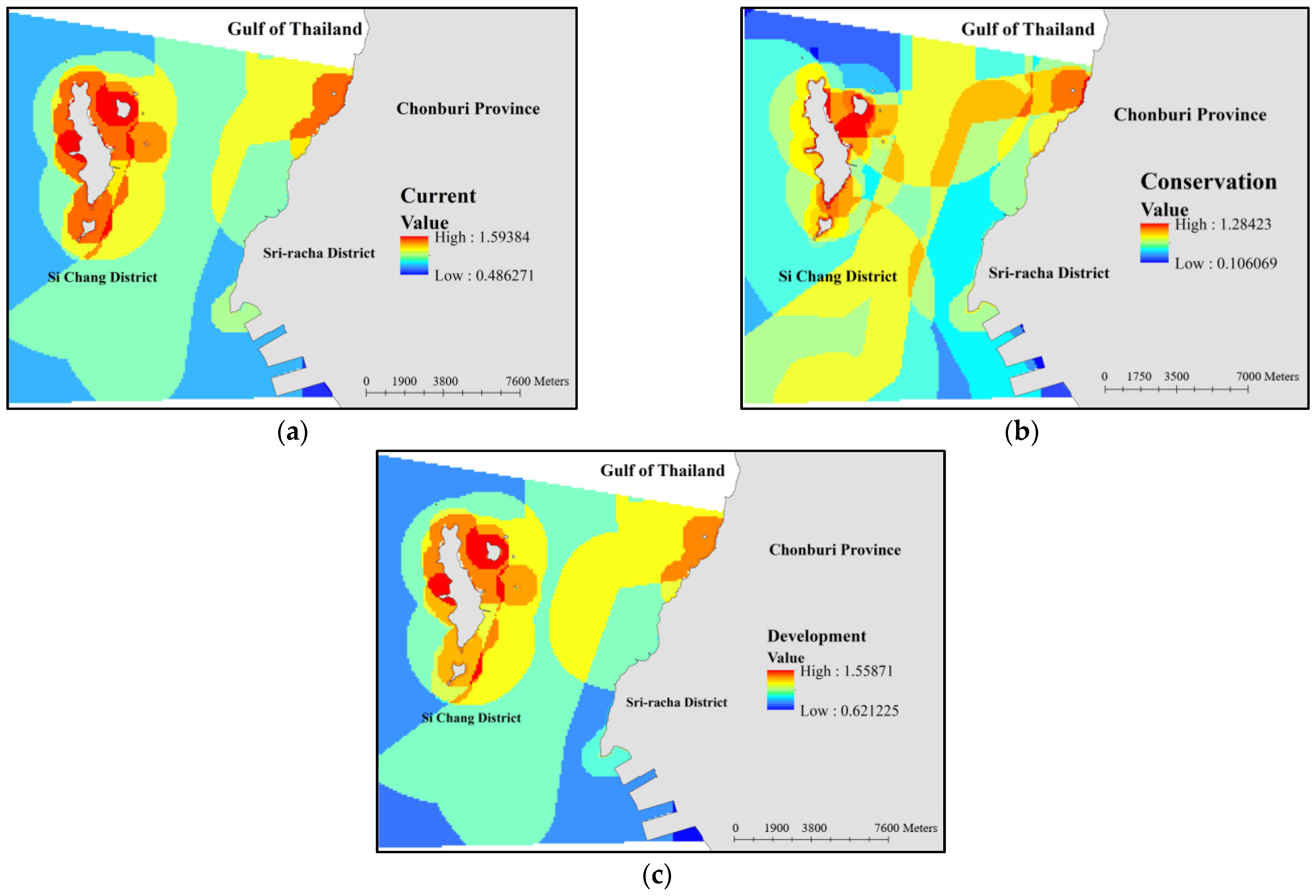
| Threat | Maximum Impact Distance/km | Weight | Decay |
|---|---|---|---|
| Coastal construction | 3 | 0.5 | exponential |
| Aquaculture | 5 | 0.8 | linear |
| Sea recreation | 5 | 0.5 | exponential |
| Beach recreation | 3 | 0.6 | exponential |
| Cargo mooring | 3 | 1 | linear |
| Diving | 3 | 0.4 | linear |
| Commercial fisheries | 3 | 0.6 | exponential |
| Local fisheries | 8 | 0.8 | linear |
| Marine transportation | 1 | 0.5 | linear |
| LULC Types | Habitat | Threats | |||||||||
|---|---|---|---|---|---|---|---|---|---|---|---|
| Breakwater | Coastal Construction | Aquaculture | Sea Recreation | Beach Recreation | Cargo Mooring | Diving | Commercial Fisheries | Local Fisheries | Marine Transportation | ||
| Sandy shore | 1 | 1 | 1 | 0.5 | 0.5 | 1 | 1 | 0 | 0 | 0.5 | 0 |
| Rocky shore | 1 | 0.7 | 1 | 0 | 0.5 | 0.8 | 0.8 | 0 | 0 | 0.5 | 0 |
| Coral reefs | 1 | 0 | 1 | 0.5 | 0.5 | 0 | 1 | 0.5 | 1 | 0.8 | 0.7 |
| Soft bottom | 1 | 1 | 0.8 | 0.8 | 0.2 | 0 | 1 | 0 | 0.6 | 0.4 | 0.8 |
| Sandy shore | 1 | 1 | 1 | 0.5 | 0.5 | 1 | 1 | 0 | 0 | 0.5 | 0 |
| Rocky shore | 1 | 0.7 | 1 | 0 | 0.5 | 0.8 | 0.8 | 0 | 0 | 0.5 | 0 |
| Criteria | Low Risk (1) | Medium (2) | High (3) | No Score (0) |
|---|---|---|---|---|
| Exposure criteria | ||||
| Spatial overlap | Yes | - | - | N/A |
| Temporal overlap | Habitat and stressor co-occur for 0–4 m/years. | Habitat and stressor co-occur for 4–8 m/years. | Habitat and stressor co-occur for 8–12 m/years. | N/A |
| Intensity | Low intensity | Medium intensity | High intensity | N/A |
| Management effectiveness | Very effective | Somewhat effective | Not effective, poorly managed | N/A |
| Consequence criteria (sensitivity) | ||||
| Change in area | Low loss in area (0–20%) | Medium loss in area (20–50%) | High loss in area (50–100%) | N/A |
| Change in structure | Low loss in structure (for biotic habitats, 0–20% loss in density; for abiotic habitats, little to no structural damage) | Medium loss in structure (for biotic habitats, 20–50% loss in density; for abiotic habitats, partial structural damage) | High loss in structure (for biotic habitats, 50–100% loss in density; for abiotic habitats, total structural damage) | N/A |
| Frequency of natural disturbance rating | Frequent (daily to weekly) | Intermediate frequency (several times per year) | Rare (annually or less often) | N/A |
| Consequence criteria (resilience) | ||||
| Natural mortality rate rating | High mortality (e.g., 80% or higher) | Moderate mortality (e.g., 20–50%) | Low mortality (e.g., 0–20%) | N/A |
| Recruitment | Annual or more often | Every 1–2 years. | Every 2+ years. | N/A |
| Connectivity | Highly connected relative to dispersal distances | Medium connectivity | Low connectively relative to dispersal distances | N/A |
| Recovery time | Less than 1 year. | 1–10 years. | More than 10 years. | N/A |
Disclaimer/Publisher’s Note: The statements, opinions and data contained in all publications are solely those of the individual author(s) and contributor(s) and not of MDPI and/or the editor(s). MDPI and/or the editor(s) disclaim responsibility for any injury to people or property resulting from any ideas, methods, instructions or products referred to in the content. |
© 2023 by the authors. Licensee MDPI, Basel, Switzerland. This article is an open access article distributed under the terms and conditions of the Creative Commons Attribution (CC BY) license (https://creativecommons.org/licenses/by/4.0/).
Share and Cite
Umprasoet, W.; Mu, Y.; Somrup, S.; Junchompoo, C.; Guo, Z.; Zhang, Z. Assessment of Habitat Risks Caused by Human Activities and Integrated Approach to Marine Spatial Planning: The Case of Sriracha District—Sichang Island. Coasts 2023, 3, 190-208. https://doi.org/10.3390/coasts3030012
Umprasoet W, Mu Y, Somrup S, Junchompoo C, Guo Z, Zhang Z. Assessment of Habitat Risks Caused by Human Activities and Integrated Approach to Marine Spatial Planning: The Case of Sriracha District—Sichang Island. Coasts. 2023; 3(3):190-208. https://doi.org/10.3390/coasts3030012
Chicago/Turabian StyleUmprasoet, Wanchanok, Yongtong Mu, Supannee Somrup, Chalatip Junchompoo, Zhen Guo, and Zhiwei Zhang. 2023. "Assessment of Habitat Risks Caused by Human Activities and Integrated Approach to Marine Spatial Planning: The Case of Sriracha District—Sichang Island" Coasts 3, no. 3: 190-208. https://doi.org/10.3390/coasts3030012
APA StyleUmprasoet, W., Mu, Y., Somrup, S., Junchompoo, C., Guo, Z., & Zhang, Z. (2023). Assessment of Habitat Risks Caused by Human Activities and Integrated Approach to Marine Spatial Planning: The Case of Sriracha District—Sichang Island. Coasts, 3(3), 190-208. https://doi.org/10.3390/coasts3030012






